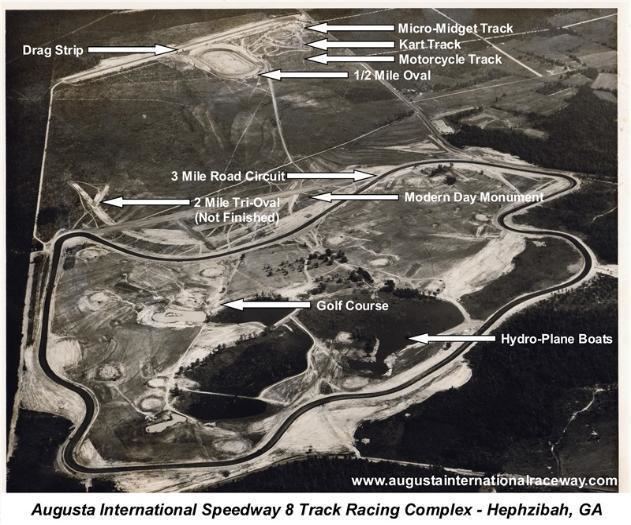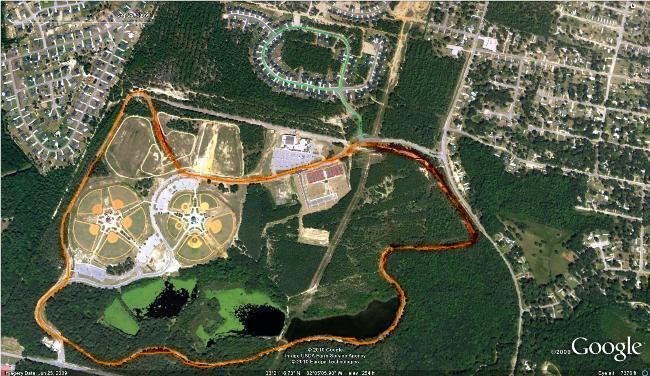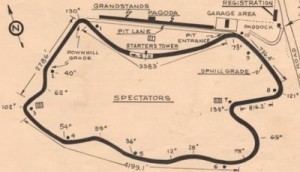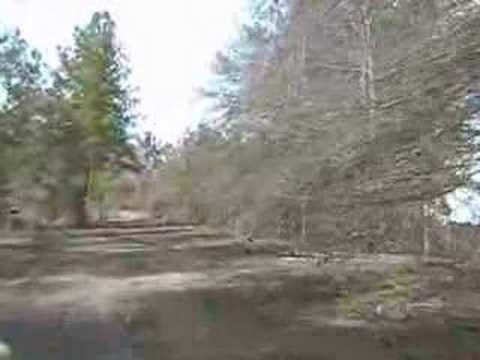Broke ground 1959 Major events 13 Major Events Opened 1960 | Closed 1970 Capacity 70,000 | |
 | ||
Owner Augusta/Richmond County Taxpayers Length Various for the different tracks km (Various for the different tracks mi) | ||
Augusta international raceway memorial
The Augusta International Raceway was a multi-use motorsports facility located in Hephzibah, Georgia, United States (just south of Augusta).
Contents
- Augusta international raceway memorial
- Half mile oval
- Road circuit
- Road course description
- Since the closure
- References

Half mile oval

The 0.5-mile (0.80 km) oval hosted NASCAR Grand National Series (now Sprint Cup Series) races from 1962 to 1969. During that time span they ran 12 races with 8 different winners.

On June 19, 1962 Joe Weatherly started on the pole position with a lap of 63.069 mph (101.500 km/h). Joe drove his Bud Moore-owned Pontiac to a 1-lap victory over Ned Jarrett. Augusta International Speedway back in 1962 was a .500 dirt mile oval. The race was 200 laps and saw only 16 cars start the race.

Less than a month later Joe did a repeat by winning on July 17, 1962 over Richard Petty. Fred Lorenzen took home the win on September 13, 1962 over Petty.

In 1963 a crowd of 4,000 in attendance saw Ned Jarrett take his Burton Robinson #11 Ford to victory lane over Richard Petty on April 4, 1963.
The 1964 season saw major changes as the track was paved with asphalt. The largest crowd ever (14,000) saw the largest field ever (30) take the green flag on November 1, 1964. The race also received the title "Jaycee 300" as the race was increased to 300 laps over the previous 200. Darel Dieringer went on to win the event.
On August 15, 1965 Dick Hutcherson won the 200 lap event with a 2.75 second lead over David Pearson. On November 14, 1965 Richard Petty took home a victory in the "Georgia Cracker 300".
November 13, 1966 saw Richard Petty win at the half mile oval with an average speed of 84.112.
On May 3, 1968 Bobby Isaac won the "Dixie 250" over Buddy Baker in his K & K Insurance Dodge. Later that year on October 5, 1968 David Pearson won over Bobby Allison in his Holman Moody-owned Ford.
On March 16, 1969 David Pearson won the first of two events at the track during this last season of racing. He won over Richard Petty with Bobby Isaac finishing third after starting on the pole with a record lap of 86.901 mph (139.854 km/h). On October 19, 1969 a field of 29 cars took the green flag at the track for the very last time. The 4,500 that attended the race only saw two lead changes between Bobby Isaac and Richard Petty. The entire race went caution free. The race time was only 1:16:12 and the average speed was 78.74 mph (126.72 km/h). Bobby Isaac won for the second time at the track.
Road circuit
Located next to the 1/2 Mile Oval was the Augusta International Raceway 3 Mile road circuit. This former track is currently being developed into the 300-acre (1.2 km2) Diamond Lakes Regional Park.
The "Augusta 510" was run on November 17, 1963 at the road circuit with a noon start time and a 5:00 PM end time. The race actually covered 417 miles (671 km) because of the time limit.
This event was the second race of the 1964 season for the Grand National Division of NASCAR which was later to become the Winston Cup Division, Nextel Cup and then the current Sprint Cup. The preceding race was held at Concord Motor Speedway and the following race was held at Jacksonville, Florida. Glenn "Fireball" Roberts was the winner of the "Augusta 510" and he would die later that season as the result of burns suffered at Charlotte Motor Speedway. He was driving a 1963 Ford and this would be his last win.
The pole sitter was Fred Lorenzen with a speed of 89.545. He would only run 12 laps before engine failure forced him to retire. Lorenzen, Roberts and sports car star Dave MacDonald were teammates for the Augusta 510 and MacDonald’s 2nd-place finish gave Holman Moody the top two spots. Weldon Adams would finish last after completing only 2 laps due to an atrocious tumble. Wendell Scott would finish 18th. He would win the next event in Jacksonville becoming the only African American to win a major NASCAR race. His feat has not been duplicated in 43 years. 36 cars started the race and 16 cars finished. The event lasted for four hours and fifty minutes and the average speed was 86.32 miles per hour (138.92 km/h). There were 10 lead changes during the event and Richard Petty led the most laps (56). The total purse for the event was $50,620. The expected turnout was to be 75,000 fans. Only 15,000 actually attended.
The "Augusta 510" was the second race of the 1964 season. Six of the top seven finishers: Glenn "Fireball" Roberts, Dave MacDonald, Joe Weatherly, Billy Wade, Larry Thomas, and Jimmy Pardue would lose their lives before the next racing season. The seventh driver was Ned Jarrett.
On March 1, 1964 the United States Road Racing Championship (USRRC) held two 150 mile events on the road course. Dave MacDonald won the first race in a King Cobra, Jim Hall was second in a Chaparral 2A and Bob Holbert was third in another King Cobra. Ken Miles and Dave MacDonald finished 1-2 in Cobra Roadsters in the afternoon race. Dave would lose his life a few weeks later at the Indy 500.
Road course description
The track itself is a 3-mile (4.8 km) long banked road course with 21 total turns. The width of the track is 45 feet (14 m).
The track elevation change is 120 feet (37 m) with the highest point being at pit exit and the lowest point on the "backstretch" where the spring fed infield lakes drain into Spirit Creek just outside the track. Joe Weatherly called this part of the track "Alligator Hollow".
The track had a 15,000-square-foot (1,400 m2) garage area (50' x 300') with two restrooms and showers.
There were seven main grandstands located along the pit lane.
The control tower was located between the fourth and fifth grandstand.
Since the closure
In 2003 a non-profit group was formed to document the former Augusta International Speedway complex and work with local officials as they develop the former 3-mile (4.8 km) road circuit into Diamond Lakes Regional Park.
The former 3-mile (4.8 km) road circuit (known as the Raceway) at the eight track complex is the only remaining track and it is being developed into the 300-acre (1.2 km2) Diamond Lakes Regional Park. The world's largest public Motorsports Memorial Project is underway in the 5Wkids Outdoor Learning Area at the former track next to the current Diamond Lakes Community Center/Library Complex.
The 5Wkids Outdoor Learning Area is a 15-year project of the Augusta International Raceway Preservation Society, a 501C3 non profit.
